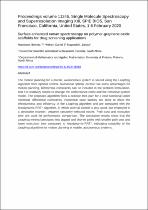JavaScript is disabled for your browser. Some features of this site may not work without it.
- ResearchSpace
- →
- Research Publications/Outputs
- →
- Journal Articles
- →
- View Item
| dc.contributor.author |
Matebese, Belinda T

|
|
| dc.contributor.author |
Withey, Daniel J

|
|
| dc.contributor.author |
Banda, MK

|
|
| dc.date.accessioned | 2021-04-06T08:43:28Z | |
| dc.date.available | 2021-04-06T08:43:28Z | |
| dc.date.issued | 2020-09 | |
| dc.identifier.citation | Matebese, B.T., Withey, D.J. & Banda, M. 2020. Leapfrog and optimal kinodynamic motion planning. http://hdl.handle.net/10204/11943 . | en_ZA |
| dc.identifier.isbn | 978-1-4503-7558-0 | |
| dc.identifier.uri | https://doi.org/10.1145/3415088.3415122 | |
| dc.identifier.uri | https://dl.acm.org/doi/proceedings/10.1145/3415088 | |
| dc.identifier.uri | http://hdl.handle.net/10204/11943 | |
| dc.description.abstract | The motion planning for a mobile, autonomous system is solved using the Leapfrog algorithm from optimal control. Numerical optimal control has some advantages for motion planning. Differential constraints can be included in the problem formulation, and it is relatively simple to change the performance index and the nonlinear system model. The proposed algorithm finds a collision-free path for a cost functional under nonlinear differential constraints. Numerical case studies are done to show the effectiveness and efficiency of the Leapfrog algorithm and are compared with the kinodynamic-RRT* algorithm, in which optimal control is also used, but employed in a piecewise manner, between randomly-selected nodes. Path cost and execution time are used for performance comparison. The simulation results show that the Leapfrog method produces less jagged and shorter paths with smaller path cost and lower execution time compared to kinodynamic-RRT*, indicating suitability of the Leapfrog algorithm for motion planning in mobile, autonomous systems. | en_US |
| dc.format | Abstract | en_US |
| dc.language.iso | en | en_US |
| dc.source | ICONIC '20: Proceedings of the 2nd International Conference on Intelligent and Innovative Computing Applications, Virtual, 24 September 2020 | en_US |
| dc.subject | Leapfrog algorithm | en_US |
| dc.subject | Kinodynamic-RRT* | en_US |
| dc.subject | Optimal controlt | en_US |
| dc.subject | Path planning | en_US |
| dc.subject | Mobile robot | en_US |
| dc.title | Leapfrog and optimal kinodynamic motion planning | en_US |
| dc.type | Conference Presentation | en_US |
| dc.description.pages | 7pp | en_US |
| dc.description.note | Copyright: 2020 ACM. Due to copyright restrictions, the attached PDF file contains the abstract of the full-text item. For access to the full-text item, please consult the publisher's website: https://doi.org/10.1145/3415088.3415122 | en_US |
| dc.description.cluster | Manufacturing | |
| dc.description.impactarea | MIAS | en_US |
| dc.identifier.apacitation | Matebese, B. T., Withey, D. J., & Banda, M. (2020). Leapfrog and optimal kinodynamic motion planning. http://hdl.handle.net/10204/11943 | en_ZA |
| dc.identifier.chicagocitation | Matebese, Belinda T, Daniel J Withey, and MK Banda. "Leapfrog and optimal kinodynamic motion planning." <i>ICONIC '20: Proceedings of the 2nd International Conference on Intelligent and Innovative Computing Applications, Virtual, 24 September 2020</i> (2020): http://hdl.handle.net/10204/11943 | en_ZA |
| dc.identifier.vancouvercitation | Matebese BT, Withey DJ, Banda M, Leapfrog and optimal kinodynamic motion planning; 2020. http://hdl.handle.net/10204/11943 . | en_ZA |
| dc.identifier.ris | TY - Conference Presentation AU - Matebese, Belinda T AU - Withey, Daniel J AU - Banda, MK AB - The motion planning for a mobile, autonomous system is solved using the Leapfrog algorithm from optimal control. Numerical optimal control has some advantages for motion planning. Differential constraints can be included in the problem formulation, and it is relatively simple to change the performance index and the nonlinear system model. The proposed algorithm finds a collision-free path for a cost functional under nonlinear differential constraints. Numerical case studies are done to show the effectiveness and efficiency of the Leapfrog algorithm and are compared with the kinodynamic-RRT* algorithm, in which optimal control is also used, but employed in a piecewise manner, between randomly-selected nodes. Path cost and execution time are used for performance comparison. The simulation results show that the Leapfrog method produces less jagged and shorter paths with smaller path cost and lower execution time compared to kinodynamic-RRT*, indicating suitability of the Leapfrog algorithm for motion planning in mobile, autonomous systems. DA - 2020-09 DB - ResearchSpace DP - CSIR J1 - ICONIC '20: Proceedings of the 2nd International Conference on Intelligent and Innovative Computing Applications, Virtual, 24 September 2020 KW - Leapfrog algorithm KW - Kinodynamic-RRT* KW - Optimal controlt KW - Path planning KW - Mobile robot LK - https://researchspace.csir.co.za PY - 2020 SM - 978-1-4503-7558-0 T1 - Leapfrog and optimal kinodynamic motion planning TI - Leapfrog and optimal kinodynamic motion planning UR - http://hdl.handle.net/10204/11943 ER - | en_ZA |
| dc.identifier.worklist | 24042 | en_US |






